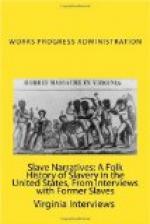“The master had a son who had been seriously injured some time before by a runaway team, and a few days after this unusual occurence with the turkey, the son died. After his death, the word of the turkey’s nesting venture and the death of the master’s son spread to this four winds, and for some time after this story was related wherever there was a public gathering with the white people or the slave population.”
All through the south a horseshoe was considered an omen of good luck. Rare indeed was the southern home that did not have one nailed over the door. This insured the household and all who entered of plesant prospects while within the home. If while in the home you should perhaps get into a violent argument, never hit the other party with a broom as it was a sure indication of bad luck. If Grandad had the rheumatics, he would be sure of relief if he carried a buckeye in his pocket.
Of all the Ten Commandments, the one broken most by the negro was: Thou Shalt Not Steal This was due mostly to the insufficent food the slaves obtained. Most of the planters expected a chicken to suddenly get heavenly aspirations once in a while, but as Mr. Fields says, “When a beautiful 250 pound hog suddenly tries to kidnap himself, the planter decided to investigate.” It occured like this:
A 250 pound hog had been fruitless. The planter was certain that the culprit was among his group of slaves, so he decided to personally conduct a quiet investigation.
One night shortly after the moon had risen in the sky, two of the negroes were seated at a table in one of the cabins talking of the experiences of the day. A knock sounded on the door. Both slaves jumped up and cautiously peeked out of the window. Lo there was the master patiently waiting for an answer. The visiting negro decided that the master must not see both of them and he asked the other to conceal him while the master was there. The other slave told him to climb into the attic and be perfectly quiet. When this was done, the tenant of the cabin answered the door.
The master strode in and gazed about the cabin. He then turned abruptly to the slave and growled, ‘Alright, where is that hog you stoled.’ ’Massa, replied the negro, ’I know nothing about no hog. The master was certain that the slave was lying and told him so in no uncertain terms. The terrified slave said, ’Massa, I know nothing of any hog. I never seed him. The Good Man up above knows I never seed him. He knows every thing and he knows I didn’t steal him; The man in the attic by this time was aroused at the misunderstood conversation taking place below him. Disregarding all, he raised his voice and yelled, ’He’s a liar, Massa, he knows just as much about it as I do.’
Most of the strictly negro folklore has faded into the past. The younger negro generations who have been reared and educated in the north have lost this bearing and assumed the lore of the local white population through their daily contact with the whites. The older negro natives of this section are for the most part employed as domestics and through this channel rapidly assimilated the employers viewpoint in most of his beliefs and conversations.




